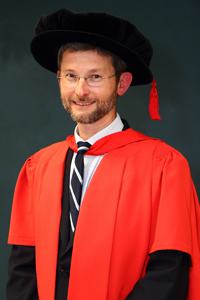Brainy neurosurgery at the foot of Africa
13 September 2010 A cut above: As Prof Graham Fieggen demonstrated, South African neurosurgeons have been pushing the envelope in their field.
A cut above: As Prof Graham Fieggen demonstrated, South African neurosurgeons have been pushing the envelope in their field.
Even in a field as technically and technologically demanding as neurosurgery, and one in which most innovations hail from Europe and the US, South Africans are blazing new paths.
That's not too startling, said Professor Graham Fieggen, the Helen and Morris Mauerberger Professor of Neurosurgery in UCT's Division of Neurosurgery, when he delivered his inaugural address in August. As Fieggen indicated in his lecture, Brain Matters: Neurosurgery in a developing country, the earliest records of surgery on the brain were found in North Africa. These are 10 000-year-old skulls bearing the marks of trephination - in which holes are made in the skull of a living person - and the papyrus on which Imhotep (the Egyptian physician who lived in the 27th century BC) recorded injuries of the spine and head. In the case of these injuries, Imhotep (considered by some to be possibly the greatest of all physicians) would prescribe that no action be taken, on the grounds that it would be futile.
Not so the treatments of Cape Town neurosurgeons at Groote Schuur and the Red Cross Children's Hospitals in recent years, declared Fieggen.
Take for example their work in the area of traumatic brain injury (TBI), very common in South Africa. "It is not widely appreciated that trauma is the number one cause of death for South Africans between the ages of four and 18, and more than half of these deaths are due to brain injury," said Fieggen. "One can summarise this data in the simple but appalling statement that the risk for a South African child of dying from a head injury is eight times that of his counterpart in the USA."
But with some clinical and management interventions, Fieggen reported, Red Cross has reduced its mortality rate for TBI (which stood at over 40% in the 1990s) to around 25% in 2005 and, today, to 10%. They pulled off this remarkable feat through three innovations - the practice of the once-controversial technique of decompressive craniectomy, in which surgeons remove part of the skull to make space for a swelling brain; consolidating the various intensive care units at the hospital into a single unit; and finally, by introducing multimodal monitoring of the brain, ie monitoring the recovery of an injured brain using a number of indicators rather than just one.
In addition, South African neurosurgeons at these hospitals have been making breakthroughs in the treatment of epilepsy through hemispherectomies, in which an entire hemisphere of the brain is removed or disconnected. And in the treatment of spasticity, which afflicts children with cerebral palsy, they've recorded notable successes with a procedure known as selective dorsal rhizotomy, in which selected nerve roots in the spinal cord are severed.
These and other examples illustrate the role that neurosurgeons do and can play in Africa, said Fieggen. But there are obstacles - the shortage of trained neurosurgeons, poor infrastructure, linguistic and cultural barriers, and the lack of research funding among them. On the other hand, UCT and other South African institutions are doing their bit to swell the ranks of neurosurgeons on the continent by providing training to doctors from other countries, and scientists are developing technology that is appropriate to conditions in Africa.
Things are also looking up in the Western Cape and at UCT, said Fieggen. The province boasts a high-functioning healthcare system and a number of well-respected experts, collaborations are afoot between the public and private sectors, and there are cross-fertilisation opportunities because of the UCT Private Academic Hospital sitting on the doorstep of training facility Groote Schuur Hospital. These factors bode well for the future of neurosurgery at the university and in the region, noted Fieggen.
"This will enable us to retain and grow the expertise we currently enjoy; develop the state-of-the-art infrastructure we need in terms of clinical space, imaging, operating theatres and even shared academic space; ensure we can train colleagues adequately; and serve as a springboard for translational research, as well as nurturing a greater interest in basic neuroscience research."
 This work is licensed under a Creative Commons Attribution-NoDerivatives 4.0 International License.
This work is licensed under a Creative Commons Attribution-NoDerivatives 4.0 International License.
Please view the republishing articles page for more information.










